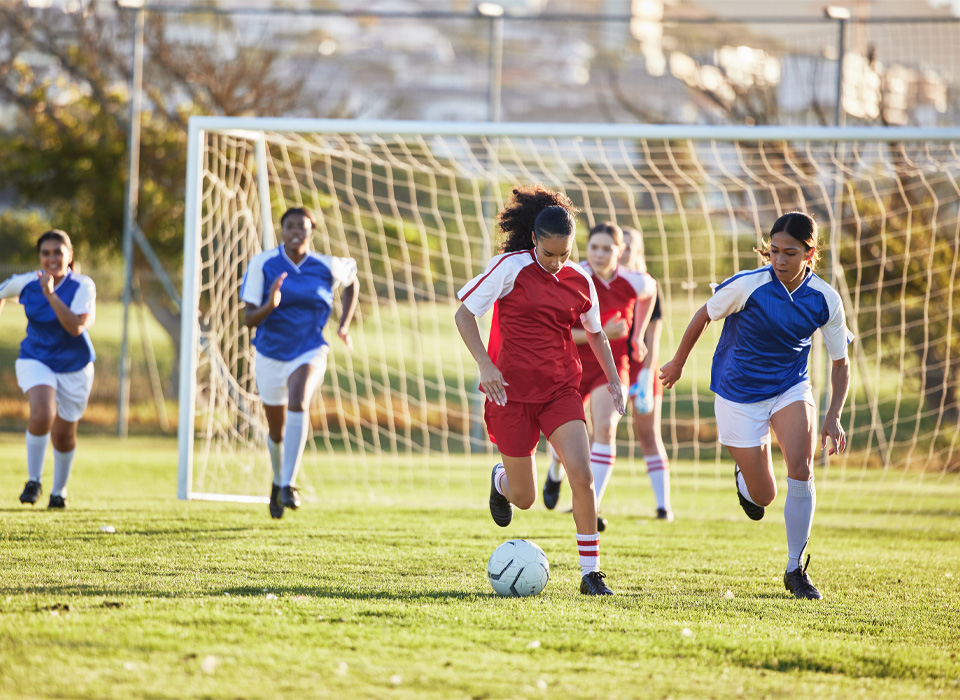The anterior cruciate ligament, or ACL, is a ligament inside of the knee that provides stability particularly when in keeping your leg steady while moving quickly or changing direction in a game. ACL tears are season-ending injuries and are unfortunately relatively common. 1 in 19 female soccer players tear their ACL, and ACL reconstruction is the most common surgery for women playing soccer.
Risk of ACL injury
Women have a greater risk of ACL injury than men do, ranging from at least two or three times the risk up to ten times the risk depending on the study.
The risk factors for ACL injury can fall into two categories: intrinsic and extrinsic factors.
Intrinsic factors
Intrinsic factors are factors that are internal and cannot be changed. Some of the intrinsic factors for women and youth soccer players’ risk of ACL tears include:
- Anatomical differences: The shape and size of the knee bones and ACL ligament can predispose to ACL injury.
- Possible hormonal effects: Hormonal changes, including those associated with the menstrual cycle and with pregnancy, may affect ligament laxity.
Extrinsic factors
Extrinsic factors are factors that are external and can be changed. Some of the extrinsic factors for women soccer player’s risk of ACL tears include:
- Strength: Weaker leg and hip muscles are more likely to result in ACL tears because the muscles can’t help keep the knee in position.
- Movement patterns: Some ways of moving are more likely to result in an ACL tear or other injury. Coaches, athletic trainers, physical therapists and personal trainers can help you change your movement style to ways that are less likely to involve injury.
- Landing mechanics: When an athlete lands with the knees coming closer together, this pattern of landing can increase the risk of ACL injury.
When ACL injuries happen
Approximately 70% of ACL injuries are non-contact meaning a player is moving quickly and their knee makes a “pop” sound as the ACL tears, without colliding into another player. The most common times for the ACL to rupture include deceleration or slowing down; cutting or changing directions; and landing after a jump.
How to prevent ACL injuries
Prevention is important as arthritis of the knee after an ACL injury can begin as early as 10 years of ACL tear. Training programs to prevent ACL injuries work! Neuromuscular training programs have been shown to reduce injury rates. Balance training and changing the way that players change direction are key in reducing risk.
The FIFA 11+ program is designed for youth and adult soccer players to reduce the risk of ACL injuries and can cut injury rate by half! You can follow along with the video during your soccer practice to reduce your risk of injury.
References
Boden BP, Sheehan FT, Torg JS, Hewett TE. Noncontact anterior cruciate ligament injuries: mechanisms and risk factors. J Am Acad Orthop Surg. 2010;18(9):520-527. doi:10.5435/00124635-201009000-00003).
International Olympic Committee Pediatric ACL Injury Consensus Group, Ardern CL, Ekås G, et al. 2018 International Olympic Committee Consensus Statement on Prevention, Diagnosis, and Management of Pediatric Anterior Cruciate Ligament Injuries. Orthop J Sports Med. 2018;6(3):2325967118759953. Published 2018 Mar 21. doi:10.1177/2325967118759953
Mancini, Sophia & Dickin, Clark & Hankemeier, Dorice & Rolston, Lindsey & Wang, Henry. (2021). Risk of Anterior Cruciate Ligament Injury in Female Soccer Athletes: A Review. Journal of Orthopedics and Orthopedic Surgery. 2. 13-21. 10.29245/2767-5130/2021/1.1128.
Mattu AT, Ghali B, Linton V, Zheng A, Pike I. Prevention of Non-Contact Anterior Cruciate Ligament Injuries among Youth Female Athletes: An Umbrella Review. Int J Environ Res Public Health. 2022;19(8):4648. Published 2022 Apr 12. doi:10.3390/ijerph19084648

